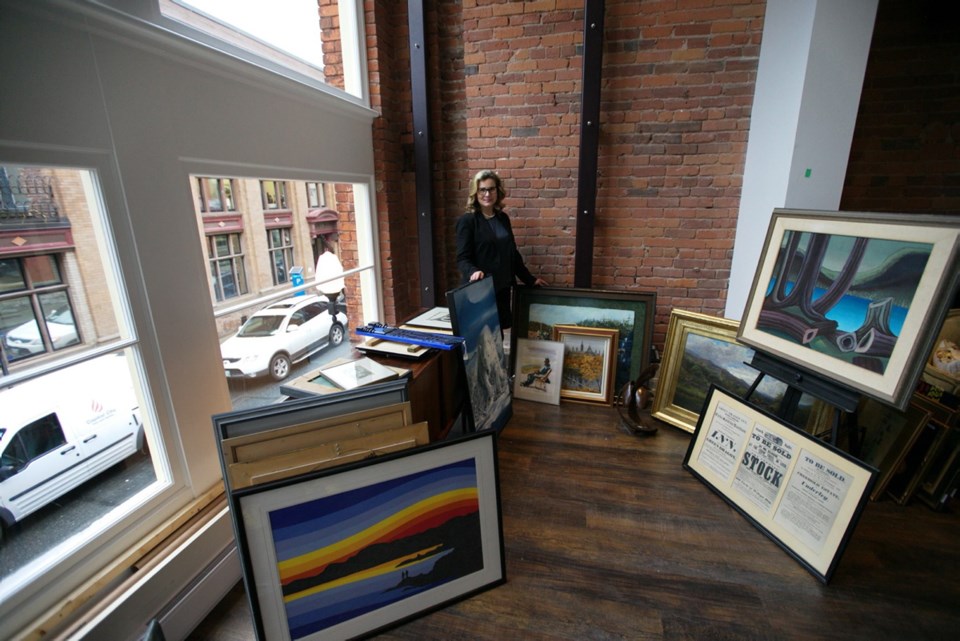 Kilshaw’s Auctioneers has moved. After 67 years in their location on Fort Street just east of Cook, their building facing imminent demolition, they have moved to striking new premises in the heart of downtown.
Kilshaw’s Auctioneers has moved. After 67 years in their location on Fort Street just east of Cook, their building facing imminent demolition, they have moved to striking new premises in the heart of downtown.
Owner Alison Ross was beaming as she showed me around 1007 Langley St. (between Broughton and Fort streets). Her auction house has a long tradition — Kilshaw’s began in England during the reign of George III — and has now jumped into the 21st century.
Their new, larger home occupies the first two floors of a heritage building that has been thoroughly renovated for their purposes by owner Richard Holmes, himself a proud member of one of Victoria’s oldest families. A beautiful mix of glass and brick, hardwood and steel, the former warehouse has been designed to accommodate the many and varied needs of this active auction business.
Just inside the glass frontage on Langley Street, a ramp leads to the consignment desk, where sellers meet staff who process their objects and put them into secure, climate-controlled storerooms behind.
“When I started at Kilshaw’s,” Ross told me, “there were no receipts. Everything was simply tagged with the seller’s name and, from our perspective, it worked just fine.” Now everything is digitally tracked.
“We’ve redesigned our whole database, inventory system and website.” Items in the fine-art sales are advertised to buyers worldwide through Kilshaw’s association with Invaluable.com, a global platform.
We moved into the sales area, at the moment empty of furnishings and a real jewel box of a space — a change from the clutter of their former home. At the front door, and visible from the sidewalk, a dedicated space is ready to show off the most impressive lots, backed by a wide stairway leading to the open-plan floor above.
There, flooded with light, is an area about the size of the previous sale room. During the week before a sale, items can be previewed there, moved in and out from a two-sided freight elevator.
The sales themselves will be conducted with a modern difference. In the old days, the objects were held aloft in a steward’s hand while the bids were called, but that’s an anachronism. Buyers have always carefully inspected the lots in advance of the sale, and now the objects will be secured in the storerooms, while on two large video screens set on the brick wall, bidders will see the lots in super detail. A dedicated sales desk will streamline the transactions.
What a lot of transactions Kilshaw’s has to handle. For every one of the weekly sales, staff have to deal with about 300 sellers … and also 300 buyers. And each item is unique.
Details of provenance, condition and authenticity have to be considered lot by lot, and the price is set only at the moment of sale. The stock is constantly arriving from every point in the compass, and an entire showroom-full is dispersed every week. Ross’s staff of 15 has to be ready to handle every aspect, from moving furniture to dealing with foreign consigners by email.
Kilshaw’s deals with a huge range of goods, from simple housewares to diamonds. For a long time, Kilshaw’s advertising money went to antiques, Ross told me, but now the top attraction is mid-century modern, Scandinavian design and post-war art.
“Most of the money is in the small things,” she pointed out. When she goes to survey estates and do appraisals, she said, people often focus on the furniture, and tell her: “We took all the stuff off the shelves and gave it to charity.” The auctioneer rolled her eyes.
“You always have to ask to be let down into the basement — that’s often where the good stuff is.”
As a woman in charge, Ross might be unique in the auction world. She was an art-history student when she was scouted by former owner Don Kilshaw.
She worked for him for some time, and then one day 10 years ago he offered her the business. Since that time, she has been the hands-on director of operations, doing everything from hauling sofas to appraising jewelry, a subject of special interest to her. Running an auction house is a huge skillset to master, and she’s always learning, never more so than with this move.
She truly loves the business, and Victoria is a great place to do business for Ross.
“We are in a really special situation, because everyone comes here to retire. This is one of the few places where our supply of things to sell is constantly replenishing.”
Families from the Maritimes bring Canadiana. Newcomers from Alberta people had huge houses there, and are very art-conscious. Last year, Ross took a course in Chinese ceramics at the Victoria and Albert Museum, because Chinese art, both ancient and contemporary, has become the most active auction category.
“And Victoria is a very good place to make discoveries,” she reminded me.
Between her last sale on Fort Street and the first on Langley, the business has continued without a pause.
“I didn’t want people to get out of their Thursday-night habit,” Ross smiled. The first sale will be on Thursday, but the doors on Langley Street are already open. They are working out the kinks before Nov. 24, their first Canadian fine-art sale in the new location. She has stockpiled some choice items, including paintings by Jack Wise and Maxwell Bates.
So now, when you drive up Fort Street you might think Kilshaw’s is gone.
“But we didn’t go,” Ross insisted. “We upgraded.”



